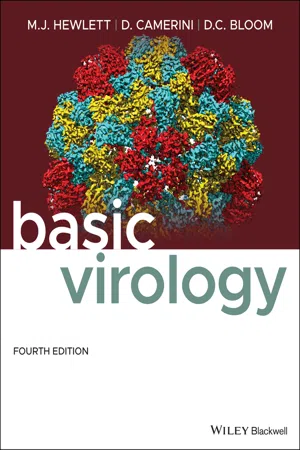Biological Sciences
Viral Structure
Viral structure refers to the physical makeup of a virus, which typically consists of genetic material (DNA or RNA) enclosed in a protein coat called a capsid. Some viruses also have an outer lipid envelope. The structure of a virus is essential for its ability to infect host cells and replicate.
Written by Perlego with AI-assistance
Related key terms
10 Key excerpts on "Viral Structure"
- eBook - ePub
- Martinez J. Hewlett, David Camerini, David C. Bloom(Authors)
- 2021(Publication Date)
- Wiley-Blackwell(Publisher)
PART II Basic Properties of Viruses and Virus–Cell Interaction- Virus Structure and Classification
- The Features of a Virus
- Classification Schemes
- The Virosphere
- The Human Virome
- The Beginning and End of the Virus Replication Cycle
- Outline of the Virus Replication Cycle
- Viral Entry
- Late Events in Viral Infection: Capsid Assembly and Virion Release
- The Innate Immune Response: Early Defense Against Pathogens
- Host Cell-Based Defenses Against Virus Replication
- The Adaptive Immune Response and the Lymphatic System
- Control and Dysfunction of Immunity
- Measurement of the Immune Reaction
- Strategies to Protect Against and Combat Viral Infection
- Vaccination – Induction of Immunity to Prevent Virus Infection
- Eukaryotic Cell-Based Defenses Against Virus Replication
- Antiviral Drugs
- Bacterial Antiviral Systems – Restriction Endonucleases
- Problems for Part II
- Additional Reading for Part II
Passage contains an image
CHAPTER 5 Virus Structure and Classification
- THE FEATURES OF A VIRUS
- Viral genomes
- Viral capsids
- Viral envelopes
- CLASSIFICATION SCHEMES
- The Baltimore scheme of virus classification
- Disease‐based classification schemes for viruses
- THE VIROSPHERE
- QUESTIONS FOR CHAPTER 5
THE FEATURES OF A VIRUS
Viruses are small compared to the wavelength of visible light; indeed, while the largest virus can be discerned in a good light microscope, the vast majority of viruses can only be visualized in detail using an electron microscope. A size scale with some important landmarks is shown in Figure 5.1 .Virus particles are composed of a nucleic acid genome or core, which is the genetic material of the virus, surrounded by a capsid made up of virus‐encoded proteins. Viral genetic material encodes the structural proteins of the capsid and other viral proteins essential for other functions in initiating virus replication. The entire structure of the virus (the genome, the capsid, and – where present – the envelope) makes up the virion or virus particle. The exterior of this virion contains proteins that interact with specific proteins on the surface of the cell in which the virus replicates. The schematic structures of some well‐characterized viruses are shown in Figure 5.2 - eBook - ePub
- Boriana Marintcheva(Author)
- 2017(Publication Date)
- Academic Press(Publisher)
Chapter 1Introduction to Viral Structure, Diversity and Biology∗
Abstract
Welcome to the diverse and exciting world of viruses. This chapter will introduce you to Viral Structure and biology on the level of the big picture with the goal to allow sufficient background to meaningfully explore the rest of the book. The chapter introduces concepts of viral biology on the example of prokaryotic viruses and highlights key differences between them, animal, and plant viruses. Examples of limited number of classical viral systems (T4, T7, herpes simplex virus type 1, HIV, influenza, tobacco mosaic virus) are used to illustrate science principles underlying the fascinating world of viruses. Viral diversity is discussed in the context of the current viral classification and evolution. Key characteristics of virus–host interactions on the cellular level and examples of viral “tricks” employed to direct cellular machinery toward fulfilling viral goals are explored.Keywords
Latency; Viral life cycles; Viral plaque; Virus evolution; Virus structureTiny, deadly, fascinating. Viruses have been around us for thousands of years and have impacted our society regardless how well we understood them. It is hard to imagine that when the word virus is mentioned, something positive will come to mind. After all, viruses got their name from the Latin word for poison, which fits them perfectly when picturing the devastating diseases they cause in humans, animals, and plants. When computers came around and self-replicating programs became the fact of life, the term virus gained a new meaning: again not exactly a positive one. Not that long time ago the Internet brought to us the idea of viral videos. Today we can describe as viral not only meningitis (hoping that we will never need to deal with one) but also anything funny, crazy, amazing, or spectacular caught on video. Now thanks to “YouTube”, the idea of Latin word for poison being associated with something different from disaster does not sound absolutely outrageous, does it? - eBook - ePub
- Stephen H. Gillespie, Kathleen B. Bamford(Authors)
- 2012(Publication Date)
- Wiley-Blackwell(Publisher)
29 Virus structure, classification and antiviral therapyViral Classification Viral classification is based on the nucleotides in the virus, its mode of replication, the structure and symmetry of the structural proteins (capsids) and the presence or absence of an envelope. Genetic Material and Replication DNA Viruses- Double-stranded DNA viruses include poxviruses, herpesviruses, adenoviruses, papovaviruses and polyomaviruses.
- Single-stranded DNA viruses include parvoviruses.
- RNA sense (positive) may serve directly as mRNA and be translated into structural protein and an RNA-dependent RNA polymerase.
- RNA antisense (negative) contains an RNA-dependent RNA polymerase that transcribes the viral genome into mRNA. Alternatively, the transcribed RNA can act as a template for further viral (antisense) RNA.
- Retroviruses have single-stranded sense RNA that cannot act as mRNA. This is transcribed into DNA by reverse transcriptase and incorporated into host DNA. The subsequent transcription to make mRNA and viral genomic RNA is under the control of host transcriptase enzymes.
A lipid envelope derived from host cell or nuclear membrane surrounds some viruses. The host membrane may incorporate viral-encoded antigens that may act as receptors for other host cells. Enveloped viruses are sensitive to substances that dissolve the lipid membrane (e.g. ether). - eBook - ePub
- Roger Hull(Author)
- 2001(Publication Date)
- Academic Press(Publisher)
CHAPTER 5Architecture and Assembly of Virus Particles
I. INTRODUCTION
Knowledge of the detailed structure of virus particles is an essential prerequisite to our understanding of many aspects of virology; for example, how viruses survive outside the cell, how they infect and replicate within the cell, and how they are related to one another. Knowledge of virus architecture has increased greatly in recent years, owing both to more detailed chemical information and to the application of more refined electron microscopic, optical diffraction and X-ray crystallographic procedures.The term capsid has been proposed for the closed shell or tube of a virus and the term capsomere for clusters of subunits seen in electron micrographs. The mature virus has been termed the virion (Caspar et al. , 1962). In membrane-bound viruses, the inner nucleoprotein core has been called the nucleocapsid. These names can, at times, cause confusion. For example, what is the capsid or the virion in a multicomponent virus such as AMV? Which is the capsomere in a virus like TBSV, where different parts of the same protein subunit are arranged with 2-fold and 3-fold symmetry? The terms encapsulation and encapsidation are now widely used to refer to the process by which a viral genome becomes encased in a shell of viral protein. These terms now have an established meaning, and I will use them. I shall also use protein subunit or structural subunit to refer to the covalently linked peptide chain. The term morphological subunit will refer to the groups of protein subunits revealed by electron microscopy and X-ray crystallography.The implications of virus structure for virus self-assembly are discussed later in this chapter. Fig. 2.1 - eBook - ePub
- Anders Liljas, Lars Liljas;Miriam-Rose Ash;G?ran Lindblom;Poul Nissen;Morten Kjeldgaard(Authors)
- 2016(Publication Date)
- WSPC(Publisher)
18 Virus Structure and Function 18.1 Virus Composition Viruses are entities with genetic material enclosed in a protective shell of proteins. Some viruses are more complex in that they also have a membrane layer enveloping the nucleic acid (enveloped viruses). They depend on a living cell for synthesis of new proteins and are normally specific for one kind of host, but there are viruses infecting all types of living cells: bacteria, archaea, fungi, plants and animals. Viruses are found with very different sizes and shapes (Table 18.1). Their genome can be either DNA or rRNA. These nucleic acids can be either single-stranded or double-stranded. The genome can be in one or several segments and can code for as many as several hundred proteins or as few as four or five. The structural proteins form the virus particles that infect new host cells, and the non-structural proteins are mostly produced only in the infected cell and used for efficient production of the components of the particles. For example, viruses with an rRNA genome always code for an enzyme that can catalyze the replication of their genetic material, since host cells are normally not capable of doing that. 18.1.1 Symmetry of the Protein Shell The protective shell around the genome is formed by protein molecules (Figure 18.1). In enveloped viruses, the lipid membrane is taken from the host cell when these viruses leave the host through a process called budding. The membrane contains virally encoded proteins that form the outer surface of the virus particle - eBook - ePub
- Rodney P. Anderson, Linda Young(Authors)
- 2016(Publication Date)
- Wiley(Publisher)
The spots are symptoms of a viral infection. Viruses are ever-present infectious particles capable of attacking diverse life forms from bacteria to mammals. Because of their intimate association with the genomes of the host cells they invade, viruses have significantly influenced the course of evolution. Long before Louis Pasteur hypothesized the existence of this smallest group of microbes, people feared their impact. Devastating viral epidemics of smallpox and poliomyelitis terrified our ancestors just as the rampant spread of AIDS has alarmed the modern human population. Because of their rapid mutation rates, new viruses are continually generated, and these may result in even more frightening and potentially deadly infections. Recent examples of lethal emerging viral infections that jeopardize humans include hemorrhagic fevers and a novel form of the swine flu.Because these infectious particles can affect almost all organisms, this chapter will describe Viral Structure, replication, and origins so we can better understand their clinical impact.The human papilloma virus is representative of basic Viral Structure.Scott Camazine/AlamyNigel Cattlin/Science Source ImagesVoisin/Phanie/Science Source ImagesCHAPTER OUTLINE
6.1Viral Structure and Classification• The Structure of Viruses• The Classification of Viruses6.2Viral Replication Cycles• Viruses Replicating in Animal Cells■ The Microbiologist’s Toolbox: Presumptive Diagnosis of a Viral Infection Using CPE Analysis• Viruses Replicating in Bacterial Cells6.3Viruses and Human Health• The Clinical Cultivation of Viruses• The Impact of Viral Infections■ Case Study: H1N1 in Young Adults• Viruses, Recurrent Infections, and Cancer■ What a Microbiologist Sees: Connecting Symptoms with the Progression of HIV6.4Prevention and Treatment of Viral Infections• The Prevention of Viral Infections■ Clinical Application: Mandatory Flu Vaccines for Health Care Providers• Antiviral Therapies• Viral Influences on Bacterial Infections6.5Viruslike Microbes• Viroids• Satellites• PrionsCHAPTER PLANNER
□ Study the picture and read the opening story.□ Scan the Learning Objectives in each section:- p. 4 □ p. 9 □ p. 16 □ p. 20 □ p. 26 □
□ Read the text and study all visuals. Answer any questions.Analyze key features
□ Process Diagram p. 10 □ p. 12 □ p. 15 □ p. 23 □□ The Microbiologist’s Toolbox, p. 14□ - eBook - ePub
- R C Matthews(Author)
- 2012(Publication Date)
- Academic Press(Publisher)
Cryoelectron microscopy is a recently developed technique. The specimen is frozen extremely rapidly in an aqueous medium. The virus is suspended in a very thin film of liquid stretching across holes in a carbon grid, which is plunged into liquid ethane that contains some ethane ice (183 °C). The freezing is so rapid that water molecules do not have time to form micro ice crystals; thus, the specimen is frozen in vitreous ice with no damage caused by crystallization of water. The method is being usefully applied to the study of virus structures or substructures that may be altered by other specimen-preparation techniques.2 THE STRUCTURE OF VIRAL GENOMES
2.1 CLASSICAL PROCEDURES
The nature of a viral nucleic acid, whether it is DNA or RNA, and whether it is single-stranded or double-stranded, circular or linear, can be established by various standard physical, chemical and enzymatic methods. Chemical and enzymatic procedures allow known special structures at the 5'- or 3'-end of linear genomic nucleic acid to be identified. Electrophoresis of purified nucleic acid from virus particles usually will give good estimates of the RNA or DNA molecular weight and the number of different size classes of genomic nucleic acid for those viruses with split genomes. The application of gene-manipulating technology is also rapidly increasing our understanding of the structure of viral genomes and how they replicate.There are two situations in which viral genome sequence information is of great use. Each of these situations has theoretical and practical aspects.2.2 GENE-MANIPULATION TECHNOLOGY
2.2.1 Importance
- Nejat Düzgünes(Author)
- 2019(Publication Date)
- Quintessence Publishing Co, Inc(Publisher)
Viruses are obligate intracellular “parasites” in that they need the machinery of their host cell to replicate. They were originally identified as microorganisms that can pass through filters that normally retain bacteria and that can cause cytopathology in cell cultures. They were thus termed “filterable agents.” Viruses are generated by the assembly of individual components encoded by viral genetic material that are synthesized in the host cell. They are either RNA or DNA viruses and normally do not contain both types of nucleic acid. Some viruses, such as the ubiquitous rhinoviruses that cause the common cold, have a protein coat, or capsid, around the nucleic acid and are described as naked capsid viruses. The capsid or nucleic acid–protein complexes called nucleoproteins may be encapsulated in a lipid bilayer membrane derived from the plasma membrane of the host cell, forming enveloped viruses. Herpesviruses and influenza virus are examples of enveloped viruses. Virus Structure Viruses range in size from 18 nm in the case of parvoviruses to about 300 nm as with poxviruses. Adenovirus is about 90 nm, and human immunodeficiency virus (HIV) is about 100 nm in diameter. Naked capsid viruses contain a DNA or RNA genome and nucleic acid binding proteins packaged in an assembly of structural proteins. Protein subunits of the capsid assemble into protomers that then form pentameric capsomeres. The latter then form the procapsid and eventually the complete capsid (Fig 28-1). Many naked capsid viruses are icosahedral, with 20 equilateral triangular faces and 12 vertices. In the hierarchical viral classification system of A. Lwoff, R. W. Horne, and P. Tournier proposed in 1962, RNA viruses are further classified into icosahedral and helical viruses. For example, picornaviruses are icosahedral naked capsid viruses- eBook - ePub
- Anil K. Sharma, Girish Kumar Gupta, Mukesh Yadav, Anil K. Sharma, Girish Kumar Gupta, Mukesh Yadav(Authors)
- 2022(Publication Date)
- De Gruyter(Publisher)
Chapter 3 VirologyMalay Kumar SannigrahiPost Graduate Institute of Medical Education and Research , Chandigarh , IndiaDeepikaThapar Institute of Engineering and Technology , Patiala , IndiaAbstract
Virology includes aspects related to viruses. Viruses are obligate intracellular parasites. They are acellular infectious agents that cannot multiply without a living host. Viruses are responsible for a large number of diseases including some fatal disease for which it is still difficult to find a stable treatment. New viruses are also emerging continuously, presenting challenges for the scientists worldwide. In this chapter, viral classification, diseases, immune response, genetic mutations, control and diagnosis of viruses have been presented.Keywords: viruses, classification, structure, pathogenesis, treatment,3.1 Introduction
Viruses are known to be obligate intracellular parasites. They are acellular infectious agents that cannot multiply without a living host. When found outside of host cells, they are metabolically inert particles. These particles have a protein coat surrounding them called capsid which may or may not be enclosed in a membrane. This protein coat (capsid) envelopes either deoxyribonucleic acids (DNA) or ribose nucleic acids (RNA), which codes for the virus proteins. When it meets a host cell, a virus can inject its genetic material into the host cell, hijacking the host’s fundamental functions for its own replication and multiplication. Unlike most living things, viruses can only divide in the infected host cell. Viruses spread in many ways and have distinct mechanism of infection, pathogenesis and symptoms. Most of the time, they are usually eliminated by the host immune system, and diseases are prominent in immunocompromised host. This chapter discusses the mode of infection, life cycle, pathogenesis, diagnosis, control and prevention of various viral infections. - eBook - ePub
- Rene Kratz(Author)
- 2011(Publication Date)
- Barrons Educational Services(Publisher)
cytopathic effects , such as visible deterioration. Some viruses whose host cells cannot be grown in culture can be grown in living animals such as rabbits, mice, and guinea pigs. Other viruses can be grown in fertilized chicken eggs. Because some viruses that are raised for vaccines are cultured in fertilized eggs, people may be asked if they have egg allergies before receiving the vaccines because some egg proteins might be present in the vaccine. All of these culture methods together have enabled us to grow, study, and develop vaccines for quite a few viruses. However, because some viral host ranges are highly specific (each virus infects only certain cell types) and because we cannot grow all cells in culture, we cannot yet grow all viruses. This makes the study of certain viruses very problematic.Identification and Classification of VirusesREMEMBERViruses that are cultivated in the lab must be grown inside host cells.Because viruses are difficult to grow and study, our understanding of the relationships between viruses is still not complete. Currently, viral classification is based upon three factors: the type of nucleic acid a virus has, how the nucleic acid is replicated, and the morphology of the virus. Viral species are defined by their genetic information and by their host range. They are generally referred to by common names that reflect the disease they cause. For example, the virus that causes AIDS is referred to as the human immunodeficiency virus. Numbers represent different strains of a species. For example, a strain of HIV is designated as HIV-1. The genus of a virus always ends in –virus and may be different than the common name for the virus. For example, the virus that causes AIDS is in the genus Lentivirus. Viral genera are grouped into families that end in –viridae. For example, HIV is in the family Retroviridae. Our classification system for viruses will continue to develop as we learn more about viruses and their relationships.Because viral genetic material largely defines its identity, viral identification relies upon molecular techniques. Viral nucleic acids are often isolated and sequenced (see Chapter 8 ) to determine the order of nucleotides. After the genetic code of a virus has been determined, it can be compared to the genetic code of other known viruses to determine its identity. Antibodies to known viruses can also be used to identify an unknown virus, just as they are used to identify bacteria (see Chapters 9 and 21
Index pages curate the most relevant extracts from our library of academic textbooks. They’ve been created using an in-house natural language model (NLM), each adding context and meaning to key research topics.









